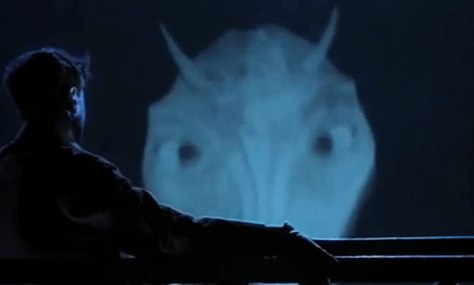
The original Quatermass Experiment TV serial in 1953 was followed up by two sequels that aired on the BBC throughout the 1950s, all of them written by series creator Nigel Kneale, and all of them eventually adapted into film by Hammer Film Productions (unlike the original, though, both sequel TV serials have been fully preserved, meaning I can actually provide a proper examination of them.) Quatermass and the Pit was the third serial (I’m sure we will eventually return to the second one, the aptly titled Quatermass II), originally airing in six parts from December 1958 to January 1959, near the tail end of the fifties Sci-Fi boom; studio disagreements kept the movie version, also written by Kneale and eventually directed by Roy Ward Baker, in limbo until 1967, when it was released in North America under the title Five Million Years to Earth. There was a different atmosphere for this kind of genre work in the late sixties (2001 would be released a year after this)—but while the time difference led to this being the only Quatermass movie in colour, the story remained intact.
As he did in the original Quatermass serial, Kneale uses the fantastical elements to posit some deeply unnerving questions about the universe we inhabit and the relationship we have with it—what makes us what we are, and can it be altered by forces beyond our control. The extraterrestrial body horror of Experiment is rendered less physical but all the more existential in The Pit, where our understanding of human history, both in cultural and evolutionary terms, is essentially unravelled. Rather than the encroaching aliens seen in the other Quatermass stories, the aliens here have already encroached—an invasion that took place in the distant past, its presence secretly looming over all mankind, until the day when it isn’t secret any more, and we are forced to confront what seems to be a monstrous part of our own nature.
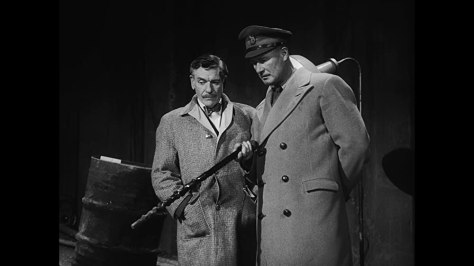
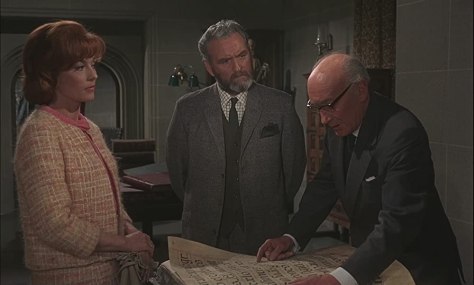
Quatermass and the Pit fits into a longstanding tradition of Science Fiction Rationalizations for the Supernatural. These stories play off the idea that some ancient part of human myth-making turn out to have alien origins, and in this case it provides the origins of our images of demons and devils—crossing over science with old-timey paranormal stuff is something that Kneale did all throughout his career (having a chance to play around with classical folklore in a modern context may have kept him making Science Fiction, a genre that he regularly stated he had little interest in.) It takes the monsters of one kind of story and reveals them to be monsters from a different kind of story, a twist that would be copied numerous times afterwards (Doctor Who has been repeating this twist since forever, and Stephen King lifted most of this plot for The Tommyknockers.) In doing so, it points to how we have always had these figures in our imaginations, a way to make some sense of the strange and frightening things in the world—magical imps and extraterrestrials fill a similar purpose, but reflect our differing understanding of the universe as history marches on. This all leads to a fairly innovative use of the aliens as well: they technically don’t appear (alive) in the story at all, remaining long dead figures of the past that still have a profound impact on the plot.


The inciting event of the story involves a work dig in Hobbs Lane (formerly Hob’s Lane), an area of Knightsbridge in London, that dredges up a human skull, which attracts the attention of paleontologist Dr. Matthew Roney (Cec Linder in the serial, James Donald in the film) and his crew. Based on his observations, the skulls found at the site belong to hominid apes that he estimates lived five million years ago, much earlier than previously thought for human ancestors, and their unusually enlarged shapes tantalize him with even more mysteries to solve. The evolutionary lineage of homo sapiens was an even more wide open field in the middle of the twentieth century, still changing the way people thought about themselves, but scientists still had to be wary of misidentification and outright hoaxes— the TV version includes a reference to the infamous “Piltdown Man” fiasco. Roney is shown to have no doubts, though: he is characterized as someone who is quite excited and also quite certain about the legitimacy and the importance of his discovery. Which is why he is eventually quite annoyed when his crew digs up a mysterious object in the earth that at first looks like an unexploded bomb, and his scientific excavation is sidelined by a necessary military operation to investigate it.

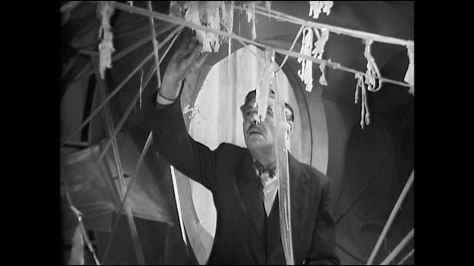
Recent history plays a very important part in this plot (although the eight year gap between the TV and film versions does muddy it a bit): England is still in a post-World War II state, so in the background they’re still in the process of rebuilding the city (the workers who find the first skull in both versions are either working on a reconstruction project or an expansion of the London underground), and remnants of the war could still be stumbled upon, like an unexploded bomb left by “Jerry.” The Pit also pulls on the even more contemporary concerns of the Cold War, which is where our old pal Bernard Quatermass (this time played by André Morell in the serial and Andrew Keir in the movie) comes in: he first appears in a heated argument with the heads of the British military, who are conscripting his experimental rocket group to help them plan and build missile bases on the moon, something he considers completely contrary to his scientific and ethical beliefs. Quatermass’ opposition has a slightly different air in the two versions: Morell comes off like a principled school teacher sort (as compared to the authoritative old scientist projected by original TV Quatermass Reginald Tate), while Keir is even fiercer in his stance, in a way that seems in line with original movie Quatermass Brian Donlevy (although, as per Kneale’s request, Keir is actually British.) There’s a definite anti-war and anti-violence standpoint evident from this early scene that dovetails into some fascinating parallels as we learn more about the Sci-Fi part of the plot, vibes that Kneale also brought into The Abominable Snowman. This theme was not just a response to nuclear arms race fears, either, but also about racist violence aimed at new immigrants in England throughout the 1950s.


Quatermass’ bullheaded military minder Colonel Breen (Anthony Bushell on TV, future Empire Strikes Back and Indiana Jones and the Last Crusade antagonist Julian Glover on film) is called in as part of the bomb squad, and Quatermass tags along, seemingly just to annoy him. Once they fully uncover the “bomb”, it becomes quite clear to everyone that it is not a bomb at all, although Breen spends the entire movie insisting that’s what it is (despite having the same main character, this is clearly the kind of continuity-free sequel that cannot have the world acknowledge the existence of aliens even though that was made entirely clear in the previous stories.) Aside from Roney and Quatermass’ logical conclusion that it must have also come from the same time as the fossils, the evidence of something odd about the large object are plentiful: it’s made of a mysterious non-metal substance, more hominid skulls are found in its hollow recesses, and a wall with a clear pentagram drawn on it is found within it. Not only that, but contact with it seems to cause strange physical ailments in people nearby, and some of the people working the site claim to have visions of tiny figures walking through walls and poltergeist-like activity—exactly the same visions claimed by people who have lived on Hob’s Lane for centuries, as dug up by Quatermass and Roney’s assistant Barbara Judd (Christine Finn on TV, Barbara Shelley in the movie.) Both the movie and serial are very talky—the movie is a fairly condensed version that still contains all the essential plot beats but can’t luxuriate in details and side characters—showing our trio of scientific minds slowly coming to the realization that not only is the object a spaceship, not only are the mummified locust-like creatures found inside it real life martians (whose horn-like antenna make them the obvious inspiration for demons and gargoyles), and not only has the buried ship been causing all the supernatural events in the area since time immemorial, but also something deeper and even more disturbing about the connection between these aliens and humanity.
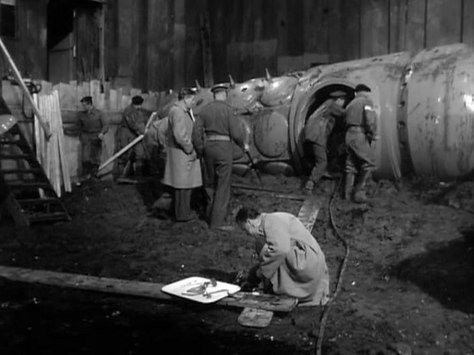
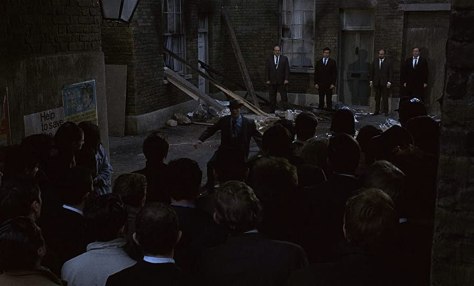
A story where humans turn out to be the result of alien genetic tinkering is, of course, a fairly standard one, although how The Pit goes about it still has a compelling power to it. We get plenty of interesting detail about this proposed new history: how Mars was a dying world beset with violent wars that Quatermass himself characterizes as a “culling of the genetically inferior”, and certain groups of Martians brought apes to their planet to selectively transform them into more intelligent beings with a predisposition for the same kind of violence that their creators had deployed against each other, and then were sent back to Earth so the insect-like creatures could rule our planet by-proxy. Although a bit implausible in conception, the use of a device developed by Roney that can record visions and memories into moving pictures gives us an opportunity to see “race memories” of a Mars enveloped in total war, with alien puppets marching across the landscape and blowing each other’s heads off (despite having a bigger budget, the movie version of this is more fake-looking than the TV version, and also doesn’t have the memorably grotesque image of puppet heads exploding.) All of the strange effects the biomechanical ship (which, in the movie, is given some veiny visual effects to make its organic nature more prominent) has on people—but, importantly, not all of them—shows how our genetic origins make us still susceptible to the power of our shadowy creators even after they’re gone. In the big finale, the ship causes whole crowds of Londoners to riot across the city, destroying property and enacting manic violence on those they are programmed to see as “weak.” These scenes of riots are effective on their own, but having spent some brief time with a number of side characters (especially in the TV version), seeing them mindlessly ripping things apart and murdering each other adds to the fairly disturbing atmosphere. Even Quatermass is shown to be influenced by the craft, so only Roney, as one of the apparent genetic anomalies that are unaffected by their Martian heritage, can stop the madness by re-interpreting the stories of ancient supernatural creatures’ weakness to iron and water into scientific terms.

This would indicate that the impulses that inspire humans to, say, want to build missile bases on the moon (or attack people based on racial differences) is an inherent trait, a curse instilled in us by a civilization that had ended up wiping itself out. Humans are inexorably linked to the monsters in this story, and we see that we can easily repeat the mistakes of the past with or without the aliens’ direct influence. The Martians symbolize our conception of evil in the way humanity’s memories of them “inspired” demonic mythology, but more importantly, they also embody all our species’ worst traits. While the movie version ends on a downer note, with the credits played over running footage of Quatermass and Judd left bereft after the noble sacrifice of Roney as the city burns behind them, the serial tries to make its final message even more explicit. Speaking at a press conference, Quatermass gives a speech imploring humankind to do better: “Every war crisis, witch hunt, race riot, and purge… is a reminder and a warning” he says to the audience both in-universe and out of it, “We are the Martians. If we cannot control the [Martian] inheritance within us, this will be their second dead planet.” Kneale displays plenty of cynicism in his work, but it’s never without some room for redemption—despite what we saw, we do not have to succumb to our apparent genetic destiny.
